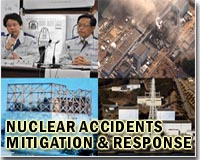| . |  |
. |
Paris (AFP) May 24, 2011 Seventy thousand people living beyond the 20-kilometre no-go zone around Fukushima should be evacuated because of radioactivity deposited by the crippled nuclear plant, a watchdog said. Updating its assessment of the March 11 disaster, France's Institute for Radiological Protection and Nuclear Safety (IRSN) highlighted an area northwest of the plant that lies beyond the 20-km (12 mile) zone whose inhabitants have already been evacuated. Radioactivity levels in this area range from several hundred becquerels per square metre to thousands or even several million bequerels per square metre, the IRSN report, issued late Monday, said. Around 70,000 people, including 9,500 children aged up to 14, live in the area, "the most contaminated territory outside the evacuation zone," the agency said. "These are people who are still to be evacuated, in addition to those who were evacuated during the emergency phase in March," Didier Champion, its environmnent director, told AFP. Staying in this area means the inhabitants would be exposed to radiation of more than 10 millisieverts (mSv)in the year following the disaster, according to the IRSN. This level is used in French safety guidelines for protecting civilian populations after a nuclear accident. In France, 10 mSv is three times the normal background radiation from natural sources. "Ten mSV is not a dangerous dose in and of itself, it's more a precautionary dose," said Champion, noting however that this figure that does not include any additional doses from contaminated food or water. The 10 mSV derives from a calculation of exposure to at least 600,000 becquerels per square metre, emitted by caesium 137 and 134, which are long-lasting radioactive elements. Of the 70,000 people in the zone identified in the IRSN report, more than 26,000 could be exposed to doses of more than 16mSv in the first year after the disaster. On May 15, Japan began to evacuate 4,000 residents of the village of Iidate-mura and 1,100 people in the town of Kawamata-cho, 30 kms from the plant. The two locations had consistently received high amounts of radioactive dust due to wind patterns. The IRSN report is based on data for radioactivity reported by the Japanese authorities and from US overflights of the zone.
Share This Article With Planet Earth
Related Links Bringing Order To A World Of Disasters A world of storm and tempest When the Earth Quakes
 UN atomic watchdog experts arrive in Japan
UN atomic watchdog experts arrive in JapanTokyo (AFP) May 23, 2011 A team of specialists from the UN atomic watchdog arrived in Japan on Monday to join other international experts investigating Japan's nuclear crisis. A six-strong delegation from the International Atomic Energy Agency (IAEA) flew to Tokyo's Narita airport from Vienna in preparation for a fact-finding mission from May 24 to June 2. In all, a 20-member mission will compile a report on the ... read more |
|
| The content herein, unless otherwise known to be public domain, are Copyright 1995-2010 - SpaceDaily. AFP and UPI Wire Stories are copyright Agence France-Presse and United Press International. ESA Portal Reports are copyright European Space Agency. All NASA sourced material is public domain. Additional copyrights may apply in whole or part to other bona fide parties. Advertising does not imply endorsement,agreement or approval of any opinions, statements or information provided by SpaceDaily on any Web page published or hosted by SpaceDaily. Privacy Statement |